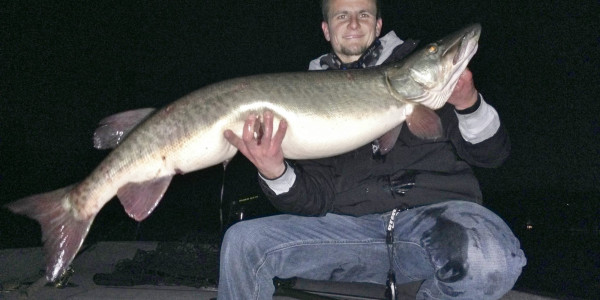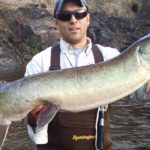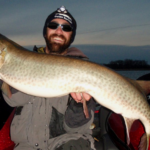Most of our gamefish resources in WI and MN are maintained by natural reproduction within their own water body. However, some of our most popular individual gamefish populations are maintained by stocking hatchery produced fish into certain designated environments. Learning to identify between stocked and wild gamefish resources is important for environmental, social, and economic reasons; but it is also important to anglers because stocked and wild members of the same species often behave very differently, even in similar environments. The most commonly stocked species in MN and WI are highly sought after species that have trouble naturally reproducing in many of our waters, but are capable of thriving once planted into biologically appropriate habitats. The 4 most popular most commonly stocked species in MN and WI are walleye, musky, trout, and salmon.
Walleye
Walleye are one of the most pressured gamefish in WI and MN. Panfish are targeted by more anglers, but their numbers are better able accommodate the pressure. Walleyes reproduce well in large lake and river environments. Therefore, such populations have the potential to be healthy and vast if managed properly. In MN and WI, these waters include Lake of the Woods, Red Lake, Leech Lake, Lake Winnibigoshish, Mille Lacs, Lake Superior, Lake Michigan, Lake Winnebago, the lower St. Louis River, the the Fox River system, the Wolf River system, the lower WI River, and the Mississippi River from Prescott to Rutledge WI.
All of these waters are capable of producing huge numbers of walleyes and big fish too, but some of them have struggled in the past or are currently struggling due to unsustainable and abusive harvest practices. These waters, if properly regulated, are capable of standing up to all of our walleye fishing wants, but many regions of WI and MN are somewhat isolated and distant from any of these waters. In some of these regions, there are some smaller lakes and rivers with naturally reproducing walleye populations, but they are few in number and could never keep up with local walleye interest as their populations are very sensitive to bad reproductive year classes and overfishing. Therefore, the DNRs of WI and MN stock many waters in these regions with walleyes to bring this opportunity to these tax paying/license buying segments of the overall population. This practice also takes some pressure off of smaller, more sensitive wild walleye populations.
Behavior of walleyes stocked into waters that never had native walleye populations vary greatly, as the introduced populations must adapt to the specific environmental conditions and forage bases in order to survive. Behaviors and therefore specific successful tactics vary greatly as well, and often fall outside what are considered normal and traditional for walleyes. For instance, in many such waters bass fishermen with spinner baits often catch more and bigger walleyes than those targeting walleyes with the traditional jigs and live bait rigs. The point is, when we create resources that were never meant to exist naturally, outcomes can be very unexpected. To take advantage of these resources, sometimes it necessary to think outside the box.
Musky
In the last 2 decades, muskies have come out of obscurity and into the mainstream, somewhat. The increased interest is good for the sport, because stocking has now created more musky resources in WI and MN than have ever existed here before. Muskies successfully reproduce naturally in only a small percentage of WI and MN waters. Without stocking, our current level of sport angler activity and tribal harvest would put far too much pressure on our musky resources for them to survive. Stocking also helps bring muskies to most regions of WI and MN, so their pursuit can be enjoyed locally by the majority of WI and MN residents. Our natural and stocked musky waters are some of the best in North America, and as such are also an important source of economic draw, as many hopeful anglers visit from other states to fish for them.
Populations of muskies established by stocking that are 8-20 years old can have quite a boom effect, both in growth rates and catchability of the fish. Muskies grow quickly on forage bases not yet exploited, i.e. suckers and ciscoes that have grown too big for other gamefish. Musky fishermen tend to ignore newly stocked musky resources either because they are not yet aware of the program or they choose not to fish it until the fish are big enough. In either case, the muskies within reach large adult sizes having seen very few if any musky lures in their prime habitats, and thus they are very susceptible to anglers once fishing begins. Fishing can be hot for several years, until the fish become pressured and educated and then things return to “normal” musky fishing. This was the case in MN from 2004-2010, when dozens of newly stocked musky resources went “on fire”, then became much tougher after some years of heavy pressure. Some populations even crashed after stocking was discontinued.
Trout and Salmon
Trout and Salmon have been stocked in the Great Lakes and many of the the inland waters of WI and MN. Brook trout and lake trout are native species to our states, and have been stocked to bolster existing populations. However, they are technically considered char and are not “true” trout. Non-native trout and salmon species most commonly stocked in our waters for roughly a century include: brown trout, rainbow trout, chinook salmon, and coho salmon. Some have taken hold and wild introduced populations have been established that need no stocking to perpetuate. Other populations would quickly cease to exist without continued stocking. The greatest success stories of wild introduced populations include brown trout in many of our inland streams and rivers, as well as wild populations of migratory brown trout, rainbow trout (steelhead), and coho salmon that live in Lake Superior and migrate into it’s tributaries to reproduce.
In terms of economics, the greatest trout and salmon success story we have are the resources of Lake Michigan from the northernmost point of Door County to the Illinois border. Lake trout are native to these waters and still reproduce in the wild. Though the chinook salmon, coho Salmon, steelhead, and brown trout populations are almost entirely maintained by stocking. Regardless of these facts, these populations draw tens of thousands of people to the region every year, creating a multi-million dollar industry. This of course comes at a cost, as the hatchery proliferation of these resources is not only necessary for their survival but extremely expensive as well. Resources budgeted for these aquaculture efforts fluctuate and therefore so do the associated fish populations, angler interest, and economic gain from the industry.
As an example of how wild introduced populations and stocked populations differ from one another, I will discuss and compare wild migratory trout and salmon of Lake Superior and stocked migratory trout and salmon of Lake Michigan. All of our coho salmon, chinook salmon, and steelhead are descendants of fish that live in the Pacific Ocean and its tributaries, (some of our rainbows are from large freshwater lakes of the west), and our brown trout’s descendents are of European ancestry.
I think hatchery assistance prevents fish from adapting properly to their environment. In wild reproduction, the unforgiving environment limits everything, including which traits are the most successful to pass on (the most suited fish claim the best reproductive areas). In hatchery reproduction, genetic material is collected in a very indiscriminate fashion and reared in the most forgiving environment possible in order to achieve the greatest return on all possible invested resources. As such, survival of the fittest is very much removed from the process during reproduction, conception, incubation, and the first stages of life after hatching. Therefore, Lake Michigan hatchery fish would theoretically be less adapted to their environment than Lake Superior wild fish. Lake Superior trout and salmon are on average much smaller than Lake Michigan fish, but pound for pound the Lake Superior fish are stronger and far better fighters when hooked. Lake Superior wild fish are smaller because Lake Superior and its tributaries are much less fertile than the Pacific Ocean where their ancestors live. It think they have also adapted to the fertility of their environment by becoming smaller in general (unable to reach larger sizes regardless).
During reproduction migrations, Lake Superior wild fish return to the streams in which they were born; Lake Michigan stocked fish often return to the point of their stocking, usually a stream or a harbor. Knowing the locations of reproduction or stocking and the life cycles and lifespans of the fish in question will greatly help fishermen locate large concentrations of adult fish (often at the peak of their life cycle and growth potential). Hatchery fish in Lake Michigan tributaries do go through the reproductive process, though it is seldom successful. However, in some rivers they are almost all intercepted before attempting to reproduce and harvested for reproductive material to be used in hatcheries. While on their reproduction migrations (prior to reproducing), both Lake Superior and Lake Michigan fish will strike presentations, though successful tactics and willingness to bite vary from one population to the next. Regardless of whether salmon are stocked or wild, when they are done with their reproduction their life cycle is over and they die. Steelhead and browns on the other hand are capable of much longer lives and can survive several migration and reproductive cycles. Often some of my best steelhead action has been post spawn as the water warms a bit and the fish need meals to build strength back after the rigors of reproduction as they migrate back onto the lake.
Resource Maintenance
Of course it would be best if every stocking effort could create an introduced wild population of gamefish. I think this goal could be worked on a little harder with some success, but again the reality is that certain fish in certain waters are going to have to be maintained by stocking and that has a price tag. If these specific resources are going to continue to exist, the funding has to be there. The bottom line is that everyone who has opinions or thoughts on this matter should be aware of exactly where their license money is going, what their state’s DNR budget is and exactly how it is being spent. This information isn’t necessarily easy to find for a reason but it is out there. (Maybe next month’s article will discuss that.) The next step is that everyone needs to make their DNR officials and their state government district representative aware of what they think of the use of these funds.
For more content, including video from Honesty Musky Television, Honest Musky Guide Service, Seminar Topics and Availability, and more articles; visit: www.honestmusky.com
Adam Glickman is an independent agent who shops across 9 different A rated insurance companies to best meet your MN and WI home, renters, auto, life, boat, and commercial insurance needs. For more information, contact Glickman at 612-750-0546 or at adam@lcisagency.com







